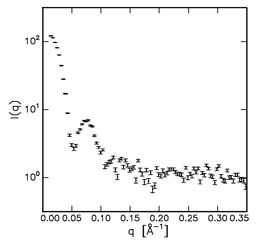
A powerful SAXS instrument is located at the Department of Chemistry. A modified version of a commercially available small-angle x-ray equipment (NanoStar), which is produced by Anton Paar, Graz, and distributed by Bruker AXS has been installed in September, 2001. The instrument consists of a powerful rotating anode x-ray source (Cu Ka , 0.3 x 0.3 mm2 source point, 6 kW power) and a pinhole camera with two Göbel mirrors for monochromatizing and focusing the beam. The data is collected efficiently by a two-dimensional position-sensitive gas detector (HiSTAR).
The instrument has originally been constructed for position-resolved studies and the commercially available instrument has a very small beam diameter of only 0.3 mm at the sample position. At the Department of Chemistry at the University of Aarhus, we have developed a high flux version of the camera in which the beam size is larger. The instrumental configuration has been optimised by numerical calculations based on phase-space analysis and Monte Carlo simulations. This leads to a setup in which the collimation part of the instrument is longer, so that divergence of the beam is similar to that of the original camera. An extra pinhole is included after the Göbel mirrors, so that the beam is well-defined after the mirrors and so that the camera has a genuine three pin-hole collimation. The parts for the modifications have been produced in the Mechanical Workshop at the Department of Chemistry. The instrument covers with one setting a scattering vector range of 0.01-0.35 Å-1. The combination of a rotating anode and Göbel mirrors gives a flux, which is about 50 times higher than that of the original version of the camera. The instrument is equipped with a thermostated glass capillary holder for solution studies. The capillary is placed directly in the vacuum and therefore additional windows are avoided leading to a very low background scattering. The high flux as well as the low background is unique for this instrument and has allowed studies of samples with fairly low concentration and scattering contrasts which cannot be studied by more conventional instruments.

During the first four weeks the instrument was in operation, test measurements on several different samples including some very weakly scattering ones have been performed. Micelles of a Brij surfactant at various concentrations and temperatures, SDS micelles, DTAB micelles, and AOT microemulsions have been measured. The instrument did in all cases perform well. It has a quite low background (100 cps for empty camera) which easily allows the use of water for absolute calibration. Water gives about 150 cps of which 6 cps is noise and 27 is from the capillary, so a 4 hours water spectrum has a quite good statistics. The count rates are for a generator power of 4.05 kW.
A sample consisting of 1% P94 in water has also been measured (sample from A. Bergmann, Anton Paar). This Pluronic, which Otto Glatter and his group also have been looking at previously, is a triblock copolymer. The results at 60°C are shown in the following plot. This is a very weakly scattering sample, however, as the plot shows, the camera produces very nice results for an accumulation time of 4 hrs.
For weakly scattering samples it is a fundamental barrier, which limits the measurements: The signal has to be significant compared to the scattering from the solvent originating from the finite compressibility of the solvent. This is a limitation, which can never be overcome.